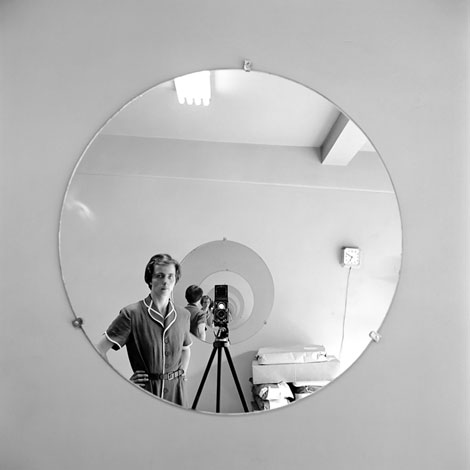We all wonder about the secret life of quiet people—surely, there’s turbulence churning beneath placid surfaces. In the fascinating new documentary Finding Vivian Maier, we follow John Maloof, a self-styled photo historian and first-time filmmaker, on his journey to unearth the secret behind a treasure trove of photographs he came upon at a Chicago auction house in 2007. After examining the lot he won, he realized what he had come upon—an undiscovered street photographer of some talent and gimlet eye, a cross between Robert Frank and Diane Arbus. He later went around buying up the rest of Maier’s photography from others who had bought lots from her archive, eventually amassing 100,000 negatives and 700 undeveloped color rolls.
Vivian Maier did indeed have a secret life, and she deliberately created mystery herself, telling different people different things, even taking on pseudonyms. Maloof unravels the story bit by bit, from the physical evidence of photographs, personal papers, and a taped diary, and from interviews with those who knew her that he gradually tracked down. Born in 1926 in New York City, Maier spent much of her youth in a small town in France, which is why she spoke with a slight accent. Returning to the U.S. in 1951, she became a live-in nanny, and took care of a series of children. Maloof and co-director Charlie Siskel interview the parents and children from those families, as well as neighbors from her last residence, an apartment building. “Vivian was a very private person,” says one. “We certainly had no idea that she took photos,” says another neighbor. The children knew she was a photographer because she would take them on long walks with a camera around her neck—sometimes, as one woman who was cared for by Maier as a child, says—“through the worse parts of town.”

Man being dragged by cops at night still. From John Maloof and Charlie Siskel’s Finding Vivian Maier. Photos by Vivian Maier, Courtesy of the Maloof Collection.
Maier documented both the well-heeled and the down-at-heels. There are photographs of society women in furs, a mother and her children in a museum. She also had a taste for the off-kilter and the dark—grubby street urchins playing with an old tire, derelicts down on their luck and crouched on the sidewalk. And she often photographed herself, caught in a storefront mirror or in reflection in plate glass—a handsome if dour-looking woman holding up the Rolleiflex. As nanny, she elicited loyalty from brothers who later helped support her, but then another former charge says Maier bullied her physically.
The story is presented like detective work, with crisp camerawork and editing, and the constant injections of Maier’s own voice— through her photographs, her tapes— help bring her to life. Maloof has done a truly remarkable job of assembling, preserving and showing Maier’s work—in LA, it was shown at Photo LA a couple of years ago and more recent at Merry Karnowsky Gallery. At the same time one cannot overlook the self-interest here. Maloof has been selling prints of Maier’s work. The films tells us the money is used to continue the work—and I gather to fund the film, as well as Maloof himself. There’s no attempt at journalistic balance—all the experts interviewed hail Maier as a gifted genius, and Maloof tosses several digs against museums who turned down showing her work. No one from these museums is interviewed. Not that they always have or should have the final word on quality or merit, but it would have given the film more balance.
Finding Vivian Maier
Written and directed by
John Maloof and Charlie Siskel. Unrated, 1 hr. 24 min.,
limited release


